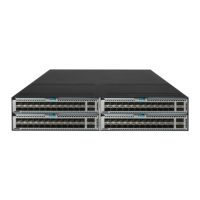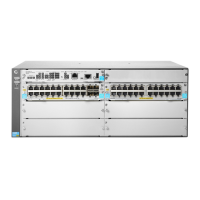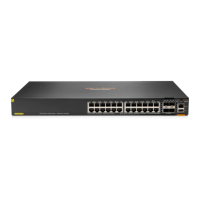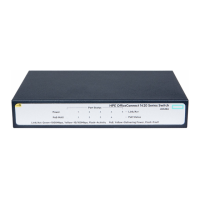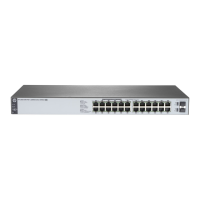150
Step Command Remarks
6. (Optional.) Enable
packet dropping in the
VLAN.
block
outbound
By default, packet dropping is disabled in
a VLAN.
This feature enables the device to drop
Layer 3 packets in a VLAN and packets
originating from the device. To drop all
packets that are received and transmitted
in the VLAN, you must configure a QoS
policy. For more information about
configuring QoS policies, see ACL and
QoS Configuration Guide.
NOTE:
• As the system default VLAN, VLAN 1 cannot be created or deleted.
• Before you delete a dynamic VLAN or a VLAN locked by an application, you must first remove
the configuration from the VLAN.
Configuring VLAN interfaces
Hosts of different VLANs use VLAN interfaces to communicate at Layer 3. VLAN interfaces are
virtual interfaces that do not exist as physical entities on devices. For each VLAN, you can create
one VLAN interface and assign an IP address to it. The VLAN interface acts as the gateway of the
VLAN to forward packets destined for another IP subnet at Layer 3.
When you configure a VLAN interface, follow these restrictions and guidelines:
• Before you create a VLAN interface for a VLAN, create the VLAN first.
• You cannot create VLAN interfaces for sub-VLANs. For more information about sub-VLANs,
see "Configuring super VLANs."
• You cannot create VLAN interfaces for secondary VLANs that have the following
characteristics:
{ Associated with the same primary VLAN.
{ Enabled with Layer 3 communication in VLAN interface view of the primary VLAN interface.
For more information about secondary VLANs, see "Configuring the private VLAN."
T
o configure basic settings of a VLAN interface:
Step Command Remarks
1. Enter system view.
system-view
N/A
2. Create a VLAN interface
and enter its view.
interface vlan-interface
interface-number
If the VLAN interface already exists,
you enter its view directly.
By default, no VLAN interfaces exist.
3. Assign an IP address to
the VLAN interface.
ip
address
ip-address { mask |
mask-length } [
sub
]
By default, no IP address is assigned to
a VLAN interface.
4. Configure the description
for the VLAN interface.
description
text
The default setting is the VLAN
interface name. For example,
Vlan-interface1 Interface
.
5. (Optional.) Specify a traffic
processing slot for the
VLAN interface.
service slot
slot-number
By default, no traffic processing slot is
specified for the VLAN interface. Traffic
on a VLAN interface is processed on
the slot at which the traffic arrives.

